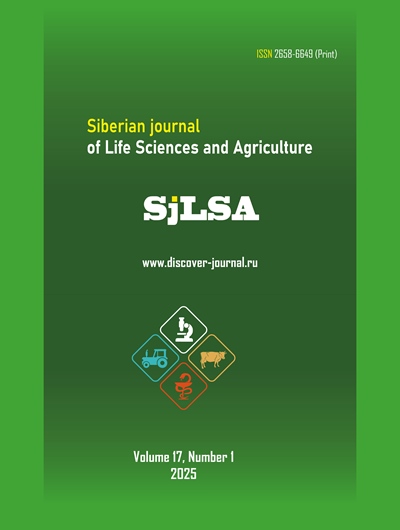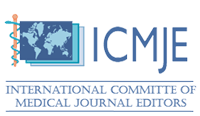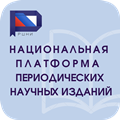Оценка функционирования фотосинтетического аппарата маслины европейской при воздействии отрицательных температур
Аннотация
Обоснование. Маслина европейская (O. europaea L.) – популярная плодовая культура, которая по занимаемой площади является второй плодовой культурой в мире и уступает только кофе. Основным лимитирующим фактором выращивания маслины в регионах, расположенных на северной границе субтропической зоны, а также в умеренном климате является их низкая морозостойкость. В связи с этим, целью настоящего исследования было оценить степень влияния отрицательных температур на функциональное состояние листьев разных генотипов O. europaea.
Материалы и методы. Исследования функционирования пигментного аппарата, стабильности хлорофилл-белкового комплекса и повреждения мембран в условиях отрицательных температур проводили на листьях следующих сортов маслины европейской: ‘Aglandau’, ‘Coreggiolo’, ‘Obilnaya’, ‘Tiflis’, ‘Dalmatica’, ‘Nikitskaya 2’, ‘Ascolano’, ‘Tossijskaya’, ‘Leccino’, ‘Razzo’. Эксперименты проведены в нативных условиях (контроль), а также после воздействия низких температур: –7°С, –10°С, –12°С и –14°C сразу и через 24 часа.
Результаты и заключение. Воздействие отрицательных температур вызывало различный отклик как в проявлении визуальных повреждений на листьях, так и в изменении их физиологических параметров. При низком градиенте температурного воздействия (–7... – 10°С) повреждены ткани листьев сортов европейской селекции ‘Coreggiolo‘, ‘Ascolano‘, ‘Leccino‘ и ‘Razzo‘: электропроводность достигала 15%, снижен индекс стабильности хлорофилла, снижены коэффициенты переменной флуоресценции, фотосинтетической активности; неконтролируемое тушение фотонов было значительно выше эффективного фотохимического квантового выхода и нефотохимического тушения. Сорта крымской и кавказкой селекции отличаются повышенной морозостойкостью. Сорта ‘Nikitskaya 2‘, ‘Tossijskaya‘ и ‘Tiflis‘ демонстрируют целостность мембран клеток листьев, стабильность содержания фотосинтетичеких пигментов и сохранение работы фотосистем на различных уровнях их организации при температуре –14°С.
Информация о спонсорстве. Исследование выполнено при финансовой поддержке гранта Российского научного фонда № 24-26-00139 на базе Уникальной научной установки "ФИТОБИОГЕН" и ЦКП «Физиолого-биохимические методы исследования растительных объектов».
EDN: WTGVZM
Скачивания
Литература
Список литературы
Гольцев, В. Н., Каладжи, Х. М., Паунов, М., Баба, В., Хорачек, Т., Мойски, Я., Коцел, Х., & Аллахвердиев, С. И. (2016). Использование переменной флуоресценции хлорофилла для оценки физиологического состояния фотосинтетического аппарата растений. Физиология растений, 63(6), 881–907. https://doi.org/10.7868/S0015330316050055
Доманская, Э. Н. (1964). Изучение физиолого-биохимических показателей сравнительной морозостойкости сортов маслины. (кандидатская диссертация). Ялта.
Иванова, М. И., Бухаров, А. Ф., & Кашлева, А. И. (2022). Корреляционный анализ признаков, характеризующих урожайность и качество продукции представителей рода Allium (подрод Сера). Известия Саратовского университета. Новая серия. Серия: Химия. Биология. Экология, 22(1), 64–73. https://doi.org/10.18500/1816-9775-2022-22-1-64-73
Нестеренко, Т. В., Тихомиров, А. А., & Шихов, В. Н. (2007). Индукция флуоресценции хлорофилла и оценка устойчивости растений к неблагоприятным воздействиям. Журнал общей биологии, 68(6), 444–458.
Нестеров, Я. С. (1972). Методика определения зимостойкости и морозостойкости плодовых и ягодных культур. Мичуринск.
Рубин, А. Б. (2000). Биофизические методы в экологическом мониторинге. Соросовский образовательный журнал, (4), 7–13.
Щенникова, И. Н., Лисицын, Е. М., & Кокина, Л. П. (2010). Изменение пигментного комплекса флаговых листьев ячменя под действием эдафического стресса. Аграрная наука Евро-Северо-Востока, (1), 24–28.
Юшков, А. Н. (2017). Адаптивный потенциал и селекция плодовых растений на устойчивость к абиотическим стрессорам. (докторская диссертация). Мичуринск: Мичуринский государственный аграрный университет.
Alekseev, A. A., Osipov, V. A., & Matorin, D. N. (2006). Method for determining the functional state of plants by chlorophyll fluorescence. Yakut State University, Yakutsk, 65 p.
Antognozzi, E., Pilli, M., Proietti, P., & Romani, F. (1990). Analysis of some factors affecting frost resistance in olive trees. Paper presented at XXIII Int. Horticultural Congress, Firenze, Italy, 4280 p.
Arias, N. S., Scholz, F. G., Goldstein, G., & Bucci, S. J. (2021). Low-temperature acclimation and legacy effects of summer water deficits in olive freezing resistance. Tree Physiology, 41(10), 1836–1847. https://doi.org/10.1093/treephys/tpab040
Baker, N. R., & Oxborough, K. (2004). Chlorophyll fluorescence as a probe of photosynthetic productivity. In Chlorophyll a Fluorescence: A Signature of Photosynthesis (pp. 65–82). Dordrecht: Springer Netherlands. https://doi.org/10.1007/978-1-4020-3218-9_3
Bartolozzi, F., & Fontanazza, G. (1999). Assessment of frost tolerance in olive (Olea europaea L.). Scientia Horticulturae, 81, 309–319. https://doi.org/10.1016/S0304-4238(99)00019-9
Bartolozzi, F., Rocchi, P., Camerini, F., & Fontanazza, G. (1999). Changes of biochemical parameters in olive (Olea europaea L.) leaves during an entire vegetative season, and their correlation with frost resistance. Acta Horticulturae, 474, 435–440. https://doi.org/10.17660/ActaHortic.1999.474.89
Brajon, O. V., Korneev, D. Yu., Snegur, O. O., & Kitaev, O. I. (2000). Instrumental studies of the photosynthetic apparatus using the induction of chlorophyll fluorescence. Methodical instructions. Kyiv, Ukraine, 11 p.
D'Angeli, S., & Altamura, M. M. (2007). Osmotin induces cold protection in olive trees by affecting programmed cell death and cytoskeleton organization. Planta, 225, 1147–1163. https://doi.org/10.1007/s00425-006-0426-6
Deslauriers, A., Caron, L., & Rossi, S. (2015). Carbon allocation during defoliation: Testing a defense-growth trade-off in balsam fir. Frontiers in Plant Science, 6, 338. https://doi.org/10.3389/fpls.2015.00338
Fontanazza, G. (1986). Renovation of olive groves damaged by frost: technical guidelines. Giornale di Agricolture, 42, 45–47.
Food and Agriculture Organization (FAO) and Codex Alimentarius Commission. Available online: http://www.fao.org/. Accessed date: November 2023. https://doi.org/10.4337/9781786438935.00011
García-Mozo, H., Pérez-Badía, R., & Galán, C. (2008). Aerobiological and meteorological factors’ influence on olive (Olea europaea L.) crop yield in Castilla-La Mancha (central Spain). Aerobiologia, 24, 13–18. https://doi.org/10.1007/s10453-007-9075-x
Ghamary, B., Rajabipour, A., Borghei, A. M., & Sadeghi, H. (2010). Some physical properties of olive. Agricultural Engineering International, 12, 104–110. https://cigrjournal.org/index.php/Ejounral/article/view/1381
Gómez-del Campo, M., & Barranco, D. (2005). Field evaluation of frost tolerance in ten olive cultivars. Plant Genetic Resources, 3(3), 385–390. https://doi.org/10.1079/PGR200592
Gordeev, R. V., Pyzhev, A. I., & Zander, E. V. (2022). Does climate change influence Russian agriculture? Evidence from panel data analysis. Sustainability, 14, 718. https://doi.org/10.3390/su14020718
Gubanova, T. B. (2019a). Resistance of Olea europaea L. varieties and forms to unfavorable winter conditions on the southern coast of Crimea. Pomiculture and Small Fruit Culture in Russia, 57, 32–41. https://doi.org/10.31676/2073-4948-2019-57-32-41
Gubanova, T. B. (2019b). The influence of negative temperatures on photosynthetic activity in some evergreen species of Oleaceae family. Subtropical and Decorative Gardening, 70, 158–167. https://doi.org/10.31360/2225-3068-2019-70-158-167
Gubanova, T. B., & Paliy, A. E. (2020). Physiological and biochemical aspects of frost resistance in Olea europaea L. Russian Journal of Plant Physiology, 67, 671–679. https://doi.org/10.1134/S1021443720030103
Ivashchenko, Y., Ivashchenko, I., & Tsiupka, S. (2021). Evaluation of olive cultivars with different photosynthetic activity of leaves. Acta Horticulturae, 1308, 99–104. https://doi.org/10.17660/ActaHortic.2021.1308.16
Kramer, D. M., Johnson, G., Kirats, O., & Edwards, G. E. (2004). New flux parameters for the determination of Qa redox state and excitation flux. Photosynthesis Research, 79, 209–218. https://doi.org/10.1023/B:PRES.0000015391.99477.0d
La Porta, N., Zacchini, M., Bartolini, S., Viti, R., & Roselli, G. (1994). The frost hardiness of some clones of olive cv. Leccino. Journal of Horticultural Science, 69(3), 433–435. https://doi.org/10.1080/14620316.1994.11516472
Lichtenthaler, H. K. (2004). Light adaptation and senescence of the photosynthetic apparatus. Changes in pigment composition, chlorophyll fluorescence parameters and photosynthetic activity. In H. K. Lichtenthaler & F. Babani (Eds.), Chlorophyll a Fluorescence: A Signature of Photosynthesis (pp. 713–736). Dordrecht: Springer Netherlands.
Lichtenthaler, H. K., & Rinderle, U. (1988). The role of chlorophyll fluorescence in the detection of stress conditions in plants. CRC Critical Reviews in Analytical Chemistry, 19(1), 29–85. https://doi.org/10.1080/15476510.1988.10401466
Lichtenthaler, H. K., & Wellburn, A. R. (1983). Determinations of total carotenoids and chlorophylls a and b of leaf extracts in different solvents. Biochemical Society Transactions, 11, 591–592. https://doi.org/10.1042/bst0110591
Martin, G. C., Denney, J. O., Ketchie, D. O., Osgood, J. W., Connel, J. H., Sibbett, G. S., Kammereck, R., Krueger, W. H., & Nour, G. A. (1993). Freeze damage and cold hardiness in olive: Findings from the 1990 freeze. California Agriculture, 47(1), 1–12. https://www.cabidigitallibrary.org/doi/full/10.5555/19930325238
Maxwell, K., & Johnson, G. N. (2000). Chlorophyll fluorescence – a practical guide. Journal of Experimental Botany, 51(345), 659–668. https://doi.org/10.1093/jexbot/51.345.659
Moreno-Alias, I., Leon, L., de la Rosa, R., & Rapoport, H. F. (2009). Morphological and anatomical evaluation of adult and juvenile leaves of olive plants. Trees, 23, 181–187. https://doi.org/10.3390/agriculture13061137
Rezaei, M., & Rohani, A. (2023). Estimating freezing injury on olive trees: A comparative study of computing models based on electrolyte leakage and tetrazolium tests. Agriculture, 13, 1137. https://doi.org/10.3390/agriculture13061137
Rinderle, U., & Lichtenthaler, H. K. (1988). The chlorophyll fluorescence ratio F690/F735 as a possible stress indicator. In H. K. Lichtenthaler (Ed.), Applications of Chlorophyll Fluorescence (pp. 189–196). Dordrecht: Kluwer Academic Publishers. https://doi.org/10.1007/978-94-009-2823-7_23
Rodrigo-Comino, J., Salvia, R., Quaranta, G., Cudlin, P., Salvati, L., & Gimenez-Morera, A. (2021). Climate aridity and the geographical shift of olive trees in a Mediterranean northern region. Climate, 9, 64. https://doi.org/10.3390/cli9040064
Roselli, G., La Porta, N., & Morelli, D. (1992). Evaluations of olive germplasm for cold-stress tolerance. Atti Convegno Germoplasma Frutticolo: Alghero, Settembre, pp. 107–112.
Roselli, G., & Venora, G. (1989). Relationship between stomatal size and winter hardiness in the olive. International Symposium on Olive Growing, 286, 89–92. https://doi.org/10.17660/ActaHortic.1990.286.15
Roselli, G., & Venora, G. (1990). Relationship between stomatal size and winter hardiness in the olive. Acta Horticulturae, 286, 89–92. https://doi.org/10.17660/ActaHortic.1990.286.15
Schreiber, U., Schliwa, U., & Bilger, W. (1986). Continuous recording of photochemical and non-photochemical chlorophyll fluorescence quenching with a new type of modulation fluorometer. Photosynthesis Research, 10, 51–62. https://doi.org/10.1007/BF00024185
Stirbet, A., & Govindjee, G. (2011). On the relation between the Kautsky effect (chlorophyll a fluorescence induction) and Photosystem II: basics and applications of the OJIP fluorescence transient. Journal of Photochemistry and Photobiology B: Biology, 104(1–2), 236–257. https://doi.org/10.1016/j.jphotobiol.2010.12.010
Tanentzap, F. M., Stempel, A., & Ryser, P. (2015). Reliability of leaf relative water content (RWC) measurements after storage: consequences for in situ measurements. Botany, 93, 535–541. https://doi.org/10.1139/cjb-2015-0065
Tsiupka, S. (2018). Historical review of olive germplasm evaluation and cultivar development in Crimea. Acta Horticulturae, 1208, 97–104. https://doi.org/10.17660/ActaHortic.2018.1208.13
van Kooten, O., & Snel, J. (1990). The use of chlorophyll fluorescence nomenclature in plant stress physiology. Photosynthesis Research, 25, 147–150. https://doi.org/10.1007/BF00033156
Xu, Z., Zhou, G., & Li, H. (2004). Responses of chlorophyll fluorescence and nitrogen level of Leymus chinensis seedling to changes of soil moisture and temperature. Journal of Environmental Sciences, 16(4), 666–669.
Yoshida, S., & Uemura, M. (1990). Responses of the plasma membrane to cold acclimation and freezing stress. In The Plant Plasma Membrane (pp. 293–320). Berlin: Springer. https://doi.org/10.1007/978-3-642-74522-5_13
Zhang, B. B., Xu, J. L., Zhou, M., Yan, D. H., & Ma, R. J. (2018). Effect of light quality on leaf photosynthetic characteristics and fruit quality of peach (Prunus persica L. Batch). Photosynthetica, 56, 1113–1122. https://doi.org/10.1007/s11099-018-0820-x
References
Gol'tsev, V. N., Kaladzhi, Kh. M., Paunov, M., Baba, V., Khorachek, T., Moyski, Ya., Kotsel, Kh., & Allahverdiev, S. I. (2016). Using variable chlorophyll fluorescence to evaluate the physiological state of the photosynthetic apparatus of plants. Fiziologiya rasteniy, 63(6), 881–907. https://doi.org/10.7868/S0015330316050055
Domanskaya, E. N. (1964). Study of physiological and biochemical indicators of comparative frost resistance of olive varieties. Unpublished doctoral dissertation, Yalta.
Ivanova, M. I., Bukharov, A. F., & Kashleva, A. I. (2022). Correlation analysis of traits characterizing yield and product quality of Allium (subgenus Sera) representatives. Izvestiya Saratovskogo universiteta. Novaya seriya. Seriya: Khimiya. Biologiya. Ekologiya, 22(1), 64–73. https://doi.org/10.18500/1816-9775-2022-22-1-64-73
Nesterenko, T. V., Tikhomirov, A. A., & Shikhov, V. N. (2007). Induction of chlorophyll fluorescence and assessment of plant resistance to adverse influences. Zhurnal obshchey biologii, 68(6), 444–458.
Nesterov, Ya. S. (1972). Methodology for assessing winter hardiness and frost resistance of fruit and berry crops. Michurinsk.
Rubin, A. B. (2000). Biophysical methods in ecological monitoring. Sorosovskiy Obrazovatel'nyy Zhurnal, (4), 7–13.
Shchennikova, I. N., Lisitsyn, E. M., & Kokina, L. P. (2010). Changes in the pigment complex of barley flag leaves under the influence of edaphic stress. Agrarnaya nauka Euro-Severo-Vostoka, (1), 24–28.
Yushkov, A. N. (2017). Adaptive potential and breeding of fruit plants resistant to abiotic stresses. Unpublished doctoral dissertation, Michurinsk: Michurinsky State Agrarian University.
Alekseev, A. A., Osipov, V. A., & Matorin, D. N. (2006). Method for determining the functional state of plants by chlorophyll fluorescence. Yakut State University, Yakutsk, 65 p.
Antognozzi, E., Pilli, M., Proietti, P., & Romani, F. (1990). Analysis of some factors affecting frost resistance in olive trees. Paper presented at XXIII Int. Horticultural Congress, Firenze, Italy, 4280 p.
Arias, N. S., Scholz, F. G., Goldstein, G., & Bucci, S. J. (2021). Low-temperature acclimation and legacy effects of summer water deficits in olive freezing resistance. Tree Physiology, 41(10), 1836–1847. https://doi.org/10.1093/treephys/tpab040
Baker, N. R., & Oxborough, K. (2004). Chlorophyll fluorescence as a probe of photosynthetic productivity. In Chlorophyll a Fluorescence: A Signature of Photosynthesis (pp. 65–82). Dordrecht: Springer Netherlands. https://doi.org/10.1007/978-1-4020-3218-9_3
Bartolozzi, F., & Fontanazza, G. (1999). Assessment of frost tolerance in olive (Olea europaea L.). Scientia Horticulturae, 81, 309–319. https://doi.org/10.1016/S0304-4238(99)00019-9
Bartolozzi, F., Rocchi, P., Camerini, F., & Fontanazza, G. (1999). Changes of biochemical parameters in olive (Olea europaea L.) leaves during an entire vegetative season, and their correlation with frost resistance. Acta Horticulturae, 474, 435–440. https://doi.org/10.17660/ActaHortic.1999.474.89
Brajon, O. V., Korneev, D. Yu., Snegur, O. O., & Kitaev, O. I. (2000). Instrumental studies of the photosynthetic apparatus using the induction of chlorophyll fluorescence. Methodical instructions. Kyiv, Ukraine, 11 p.
D'Angeli, S., & Altamura, M. M. (2007). Osmotin induces cold protection in olive trees by affecting programmed cell death and cytoskeleton organization. Planta, 225, 1147–1163. https://doi.org/10.1007/s00425-006-0426-6
Deslauriers, A., Caron, L., & Rossi, S. (2015). Carbon allocation during defoliation: Testing a defense-growth trade-off in balsam fir. Frontiers in Plant Science, 6, 338. https://doi.org/10.3389/fpls.2015.00338
Fontanazza, G. (1986). Renovation of olive groves damaged by frost: technical guidelines. Giornale di Agricolture, 42, 45–47.
Food and Agriculture Organization (FAO) and Codex Alimentarius Commission. Available online: http://www.fao.org/. Accessed date: November 2023. https://doi.org/10.4337/9781786438935.00011
García-Mozo, H., Pérez-Badía, R., & Galán, C. (2008). Aerobiological and meteorological factors’ influence on olive (Olea europaea L.) crop yield in Castilla-La Mancha (central Spain). Aerobiologia, 24, 13–18. https://doi.org/10.1007/s10453-007-9075-x
Ghamary, B., Rajabipour, A., Borghei, A. M., & Sadeghi, H. (2010). Some physical properties of olive. Agricultural Engineering International, 12, 104–110. https://cigrjournal.org/index.php/Ejounral/article/view/1381
Gómez-del Campo, M., & Barranco, D. (2005). Field evaluation of frost tolerance in ten olive cultivars. Plant Genetic Resources, 3(3), 385–390. https://doi.org/10.1079/PGR200592
Gordeev, R. V., Pyzhev, A. I., & Zander, E. V. (2022). Does climate change influence Russian agriculture? Evidence from panel data analysis. Sustainability, 14, 718. https://doi.org/10.3390/su14020718
Gubanova, T. B. (2019a). Resistance of Olea europaea L. varieties and forms to unfavorable winter conditions on the southern coast of Crimea. Pomiculture and Small Fruit Culture in Russia, 57, 32–41. https://doi.org/10.31676/2073-4948-2019-57-32-41
Gubanova, T. B. (2019b). The influence of negative temperatures on photosynthetic activity in some evergreen species of Oleaceae family. Subtropical and Decorative Gardening, 70, 158–167. https://doi.org/10.31360/2225-3068-2019-70-158-167
Gubanova, T. B., & Paliy, A. E. (2020). Physiological and biochemical aspects of frost resistance in Olea europaea L. Russian Journal of Plant Physiology, 67, 671–679. https://doi.org/10.1134/S1021443720030103
Ivashchenko, Y., Ivashchenko, I., & Tsiupka, S. (2021). Evaluation of olive cultivars with different photosynthetic activity of leaves. Acta Horticulturae, 1308, 99–104. https://doi.org/10.17660/ActaHortic.2021.1308.16
Kramer, D. M., Johnson, G., Kirats, O., & Edwards, G. E. (2004). New flux parameters for the determination of Qa redox state and excitation flux. Photosynthesis Research, 79, 209–218. https://doi.org/10.1023/B:PRES.0000015391.99477.0d
La Porta, N., Zacchini, M., Bartolini, S., Viti, R., & Roselli, G. (1994). The frost hardiness of some clones of olive cv. Leccino. Journal of Horticultural Science, 69(3), 433–435. https://doi.org/10.1080/14620316.1994.11516472
Lichtenthaler, H. K. (2004). Light adaptation and senescence of the photosynthetic apparatus. Changes in pigment composition, chlorophyll fluorescence parameters and photosynthetic activity. In H. K. Lichtenthaler & F. Babani (Eds.), Chlorophyll a Fluorescence: A Signature of Photosynthesis (pp. 713–736). Dordrecht: Springer Netherlands.
Lichtenthaler, H. K., & Rinderle, U. (1988). The role of chlorophyll fluorescence in the detection of stress conditions in plants. CRC Critical Reviews in Analytical Chemistry, 19(1), 29–85. https://doi.org/10.1080/15476510.1988.10401466
Lichtenthaler, H. K., & Wellburn, A. R. (1983). Determinations of total carotenoids and chlorophylls a and b of leaf extracts in different solvents. Biochemical Society Transactions, 11, 591–592. https://doi.org/10.1042/bst0110591
Martin, G. C., Denney, J. O., Ketchie, D. O., Osgood, J. W., Connel, J. H., Sibbett, G. S., Kammereck, R., Krueger, W. H., & Nour, G. A. (1993). Freeze damage and cold hardiness in olive: Findings from the 1990 freeze. California Agriculture, 47(1), 1–12. https://www.cabidigitallibrary.org/doi/full/10.5555/19930325238
Maxwell, K., & Johnson, G. N. (2000). Chlorophyll fluorescence – a practical guide. Journal of Experimental Botany, 51(345), 659–668. https://doi.org/10.1093/jexbot/51.345.659
Moreno-Alias, I., Leon, L., de la Rosa, R., & Rapoport, H. F. (2009). Morphological and anatomical evaluation of adult and juvenile leaves of olive plants. Trees, 23, 181–187. https://doi.org/10.3390/agriculture13061137
Rezaei, M., & Rohani, A. (2023). Estimating freezing injury on olive trees: A comparative study of computing models based on electrolyte leakage and tetrazolium tests. Agriculture, 13, 1137. https://doi.org/10.3390/agriculture13061137
Rinderle, U., & Lichtenthaler, H. K. (1988). The chlorophyll fluorescence ratio F690/F735 as a possible stress indicator. In H. K. Lichtenthaler (Ed.), Applications of Chlorophyll Fluorescence (pp. 189–196). Dordrecht: Kluwer Academic Publishers. https://doi.org/10.1007/978-94-009-2823-7_23
Rodrigo-Comino, J., Salvia, R., Quaranta, G., Cudlin, P., Salvati, L., & Gimenez-Morera, A. (2021). Climate aridity and the geographical shift of olive trees in a Mediterranean northern region. Climate, 9, 64. https://doi.org/10.3390/cli9040064
Roselli, G., La Porta, N., & Morelli, D. (1992). Evaluations of olive germplasm for cold-stress tolerance. Atti Convegno Germoplasma Frutticolo: Alghero, Settembre, pp. 107–112.
Roselli, G., & Venora, G. (1989). Relationship between stomatal size and winter hardiness in the olive. International Symposium on Olive Growing, 286, 89–92. https://doi.org/10.17660/ActaHortic.1990.286.15
Roselli, G., & Venora, G. (1990). Relationship between stomatal size and winter hardiness in the olive. Acta Horticulturae, 286, 89–92. https://doi.org/10.17660/ActaHortic.1990.286.15
Schreiber, U., Schliwa, U., & Bilger, W. (1986). Continuous recording of photochemical and non-photochemical chlorophyll fluorescence quenching with a new type of modulation fluorometer. Photosynthesis Research, 10, 51–62. https://doi.org/10.1007/BF00024185
Stirbet, A., & Govindjee, G. (2011). On the relation between the Kautsky effect (chlorophyll a fluorescence induction) and Photosystem II: basics and applications of the OJIP fluorescence transient. Journal of Photochemistry and Photobiology B: Biology, 104(1–2), 236–257. https://doi.org/10.1016/j.jphotobiol.2010.12.010
Tanentzap, F. M., Stempel, A., & Ryser, P. (2015). Reliability of leaf relative water content (RWC) measurements after storage: consequences for in situ measurements. Botany, 93, 535–541. https://doi.org/10.1139/cjb-2015-0065
Tsiupka, S. (2018). Historical review of olive germplasm evaluation and cultivar development in Crimea. Acta Horticulturae, 1208, 97–104. https://doi.org/10.17660/ActaHortic.2018.1208.13
van Kooten, O., & Snel, J. (1990). The use of chlorophyll fluorescence nomenclature in plant stress physiology. Photosynthesis Research, 25, 147–150. https://doi.org/10.1007/BF00033156
Xu, Z., Zhou, G., & Li, H. (2004). Responses of chlorophyll fluorescence and nitrogen level of Leymus chinensis seedling to changes of soil moisture and temperature. Journal of Environmental Sciences, 16(4), 666–669.
Yoshida, S., & Uemura, M. (1990). Responses of the plasma membrane to cold acclimation and freezing stress. In The Plant Plasma Membrane (pp. 293–320). Berlin: Springer. https://doi.org/10.1007/978-3-642-74522-5_13
Zhang, B. B., Xu, J. L., Zhou, M., Yan, D. H., & Ma, R. J. (2018). Effect of light quality on leaf photosynthetic characteristics and fruit quality of peach (Prunus persica L. Batch). Photosynthetica, 56, 1113–1122. https://doi.org/10.1007/s11099-018-0820-x
Просмотров аннотации: 258 Загрузок PDF: 46
Copyright (c) 2025 Sergei Yu. Tsiupka, Valentina A. Tsiupka, Ilya V. Bulavin

Это произведение доступно по лицензии Creative Commons «Attribution-NonCommercial-NoDerivatives» («Атрибуция — Некоммерческое использование — Без производных произведений») 4.0 Всемирная.






















































